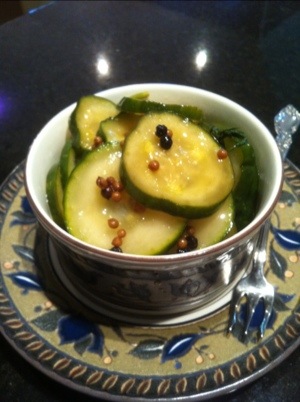These pickles (recipe hehttp://www.nytimes.com/recipes/12579/Bread-and-Butter-Pickles.htmlre) are SO easy and delicious. They perish quickly, but don’t last long, at least not at our house, so it hasn’t been a problem. I haven’t tried the ketchup and mustard recipes (also included in the article) but am planning to try soon. I do occasionally make my own mayonnaise, which is absolutely transcendent (and surprisingly easy), so I’ll post that recipe and photo the next time I make it.
Category: Misc
Cream Cheese Herb Spread
Recipe here. This stuff is flat-out delicious. It tastes exactly like Boursin or Alouette. Fantastic with crackers or spread onto your favorite veggies. Also great as a sandwich spread. I add a tiny bit of dried parsley and a bit of celery salt to the specified recipe.
It has come to my attention that the link posted in this recipe is no longer working, so I decided to post the whole recipe.
Cream Cheese Herb Spread
1 garlic clove, pressed or minced
2 8-ounce packages cream cheese (softened)
1 cup butter (softened)
1 tsp dried oregano
1/4 tsp dried dill weed
1/4 tsp dried basil
1/4 tsp dried marjoram
1/4 tsp dried thyme
1/4 tsp ground black peper
1/4 tsp celery salt
1/2 tsp dried parsley
Stir all ingredients together until smooth (the softer your cream cheese and butter are, the easier this will be.) Adjust seasonings accordingly. Sometimes I up the herb amounts just a little and/or add a little sprinkle of paprika. Cheese mixture may be refrigerated for up to one week or frozen up to three months.
Makes 3 cups.
Chocolate-Chip Walnut Biscotti
Recipe here. Obviously, I’m a little obsessed with biscotti lately. I’ve really enjoyed learning how to make these and am experimenting with as many new recipes as possible. These are absolutely divine. Super rich and very flavorful. I use a small offset spatula to spread the melted chocolate on, rather than dipping, as I find it a little easier and neater. I also use pecans instead of walnuts, because I live in Texas and walnuts are evil.
Thanksgiving Cheese Plate
Instructions and recipe for Cranberry Jam here.
This was a little bit of trouble, but the bread crisps and jam can be made ahead of time and were absolutely delicious.
Asparagus Pain Perdu
Recipe here.
This was FANTASTIC. I was a little too lazy rushed to make the homemade tomato jam, and used a good quality jarred pasta sauce, instead, but now that tomatoes are in high season, I might give it a try. This is a great breakfast dish, but would also be fantastic for brunch, lunch or a light dinner or even a late-night snack.
Cinnamon-Swirl Bread
Giada’s Sweet Pea Crostini
Recipe here.
I made this recently on a lazy afternoon at home, when we had eaten a large, late breakfast and had a nice dinner planned, so we didn’t feel like a full lunch. It made a perfect light and relatively healthy snack to tide us over until dinner.. The kids even liked it and the ingredients are all things that are easy to keep on hand, so it would make a great last-minute hors d’oeuvre for unexpected guests. This would work with almost any kind of bread (I used a country loaf and just cut each slice in half to make each piece smaller) and wouldn’t HAVE to be baguette. We have mint growing in our yard, so we always have it on hand, but if you didn’t have any and chose to leave it out, it wouldn’t be the end of the world. I left the prosciutto off the top, because it was a last-minute thing and I didn’t have any, but it would have been nice. A little cooked, cooled and crumbled bacon would be nice, too. Or, you can go vegetarian, as I did, and cook the peas in vegetable stock, rather than chicken stock. Yum.
Artichokes
Yum. We love artichokes around here and are always so excited when we start to see them in the springtime. It seems a little early this year, since it’s still unseasonably frigid right now, but we love ’em, so we’re going for it.
Stay tuned and I’ll show you how to disembowel these suckers and get ’em fit for human consumption. You do have to wonder what the first guy to try to eat these was thinking. He must have been pretty freakin’ hungry to even attempt it; these things are a lot of work for not a lot of sustenance, but, what tasty sustenance it is!
Lop off the bottom of the artichoke. Leave maybe an inch of the stem. Remove any small, shrimpy leaves from around the stem – there are usually 4 or 5 that are inedible and just in the way…
Off with her head! Chop off the pointy top of your artichoke – maybe an inch or an inch and a half.
This is about what it should look like.
Trim off the pointy edges of each leaf with scissors or kitchen shears.
This is what your fully-prepped artichoke should look like.
Give the entire artichoke a quick rinse in some running water, if you’re finicky. Them rub down all of the cut surfaces (top, bottom and leaf tips) with half of a lemon, squeezing a bit of the juice onto the artichoke as you go.
Repeat with as many artichokes as you are planning to cook. I can only fit 4 in my largest stockpot, so that’s what we usually do. For a family dinner, we usually will each have our own artichoke as a first course, but if I’m serving a crowd, I’ll make some for everyone to share.
Place the artichokes in a very large stock pot and cover them with water. Sprinkle in a generous amount of kosher salt and squeeze the rest of the lemon juice into the water, too. Or just throw the lemon in the pot. Whichever.
Cover the pot and cook over high heat until the artichokes are soft enough that you can pull a leaf off, but not so soft that they’re falling apart. This can take up to an hour, but I’d start to check them after about 40 minutes. This is the only tricky part, but even if they’re a bit overcooked, they’re still pretty fabulous. Undercooked, however, is NOT good, so err on the side of cooking them to long, if you’re in doubt.
While they’re cooking, you can make the dipping sauces. The first sauce is VERY easy: Get a ramekin. Put about 6 Tbsp of butter in it. Melt it in the microwave. Sprinkle a little kosher salt in it if you used unsalted butter (which you should be doing, by the way, but that’s a whole other topic…)
The second sauce isn’t much more difficult. Mix the following ingredients together in another small bowl or ramekin:
1/3 cup mayonnaise
1 garlic clove, minced or pressed
a sprinkle of kosher salt and freshly ground pepper
a little squeeze of fresh lemon juice (about 1 teaspoon)
When the artichokes are done, pull ’em out of the water (be careful – use BBQ tongs) and serve ’em along with the dips.
To eat ’em, pull the leaves off, one at a time, drip them in the sauce of your choice (or naked’s good, too) and use your teeth to scrape the meat off of each leaf.
Once you get to the center of the artichoke, you’ll see a fuzzy thing that looks like the inside of a flower (well…it kind of *IS* the inside of a flower.) This is called the choke.
You don’t want to eat that, so gently pull out that fuzzy choke with your fingers (if it’s cooled down enough) or a gently scrape it out with a spoon and discard it. That bottom (under the choke) part?
Well, that’s your reward for all your hard work, baby…that’s the artichoke heart. Dip it in some butter or aioli (that’s the fancy name for that mayo sauce we made earlier) and DIG IN. If you’re really disciplined (or full,) you can save it, after you eat all the leaves, and toss it into an omelet for your breakfast the next day. Yum.
Green Goddess Salad Dressing
At the risk of overusing an obnoxious “foodie” word, I must say, about this dressing: nom nom nom.
Quite delicious. A little time-consuming, but worth the effort and the recipe (which can be found here) makes a generous amount.























